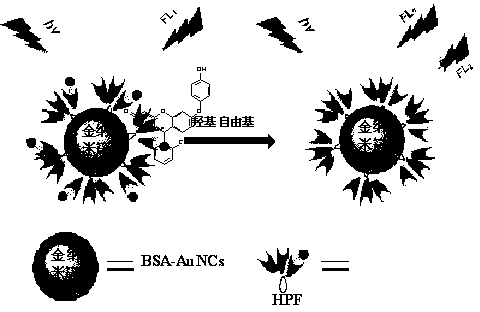Ratio fluorescent probe for detecting hydroxyl radical and synthesis method and application of ratio fluorescent probe
A fluorescent probe and free radical technology, which is applied in the field of biological detection technology and clinical medical detection, can solve the problem that the measurement environment error cannot be effectively avoided, and achieve the effects of good selectivity, low cytotoxicity and good biocompatibility.
- Summary
- Abstract
- Description
- Claims
- Application Information
AI Technical Summary
Problems solved by technology
Method used
Image
Examples
Embodiment 1
[0031] Example 1: Synthesis of ratiometric fluorescent probes for hydroxyl radicals
[0032] 1. Under the conditions of 37 ℃ and sufficient magnetic stirring, add 5 mL of 10 mM chloroauric acid aqueous solution to 55 mL of bovine serum albumin aqueous solution with a mass concentration of 50 mg / mL, and then add 0.5 mL of 1 M NaOH solution, continue to react for 12 h; use a dialysis membrane (MWCO: 3500) to dialyze the reaction product in ultrapure water to obtain a BSA-AuNCs solution;
[0033] 2. At room temperature, add a volume of 10 μL of dimethylformamide solution of HPF with a concentration of 5 mM to a phosphate buffer solution with a pH of 7.4, and add 0.0040 g of 1-(3-dimethylaminopropyl)- 3-Ethylcarbodiimide and 0.0040g N-hydroxysuccinimide activated the carboxyl groups in HPF, and then added 400 μL of the above BSA-AuNCs solution to react for 10 h; After dialysis for 4 h, a ratiometric fluorescent probe solution was obtained.
Embodiment 2
[0034] Example 2: Ratio probe with · Determination of fluorescence properties after OH reaction
[0035] 1. The generation method of hydroxyl radicals:
[0036] Hydroxyl free radical among the present invention utilizes Fenton reaction to produce, and it reacts according to following:
[0037]
[0038] in · OH to Fe 2+ To quantify, to ensure Fe 2+ Fully reacted, Fe 2+ with H 2 o 2 The concentration ratio is 1:10, the reaction medium is PBS buffer solution with pH 7.4, FeCl 2 solution and H 2 o 2 It is required to be equipped and used now.
[0039] 2. Fluorescence test:
[0040] (1) Measurement parameters of fluorescence spectrum:
[0041] Fluorescence detection was performed with a F-2700FL fluorescence instrument, the voltage of the photomultiplier tube was 700 V, the slit width was 2.5 nm, the scanning range was 500-750 nm, the scanning speed was 1200 nm / min, and the excitation wavelength was 488 nm. · In the presence of OH, the positions of the two fluo...
PUM
 Login to View More
Login to View More Abstract
Description
Claims
Application Information
 Login to View More
Login to View More - R&D
- Intellectual Property
- Life Sciences
- Materials
- Tech Scout
- Unparalleled Data Quality
- Higher Quality Content
- 60% Fewer Hallucinations
Browse by: Latest US Patents, China's latest patents, Technical Efficacy Thesaurus, Application Domain, Technology Topic, Popular Technical Reports.
© 2025 PatSnap. All rights reserved.Legal|Privacy policy|Modern Slavery Act Transparency Statement|Sitemap|About US| Contact US: help@patsnap.com



